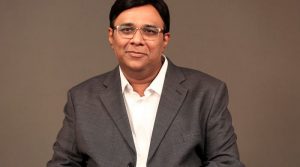 Kaustubh Sonalkar is currently the President – HR & Admin, Chief Executive Officer – Essar Foundation and Chief Executive Officer of Essar Corporate Services LLP, Essar Group.
Kaustubh Sonalkar is currently the President – HR & Admin, Chief Executive Officer – Essar Foundation and Chief Executive Officer of Essar Corporate Services LLP, Essar Group.
How important is Performance Management (P.M.) in today’s high-flux organization?
Performance Management System (PMS) is the backbone of any organization. But unfortunately, the process is hyped and has become scientific. We (HR) the custodians of the process has ensured it loses its impact. How can Tiger Woods be one of the successful golfers of all times if he was only given direction, feedback and development plan only once a year!
The traditional end of the year appraisal, designed in the 1970s, is clearly not effective anymore. In 2015, Global Human Capital Trends research says 82 percent of companies reported that performance evaluations were not worth the time. A separate study reported that 41 percent of companies found the process to have widespread manager bias, and 45 percent believed performance evaluations did not motivate employees instead did the OPPOSITE!
In my opinion, Performance Management is an ART – to align with business outcomes/goals. The process has to shift from focussing on employee’s individual achievements to evaluating the contributions to the team and the team’s impact on the overall organizational goals. Because if the organization’s goals are met, everything else naturally takes place. The collective performance and contributions of all players will help in winning the prize money!
Performance Management System with its traditional approach is a passe. The current system definitely needs a relook and a disruption towards more meaningful Performance Management.
The new model should include flavors of TRUST, INCLUSION, DIVERSITY, and CLARITY OF ROLES. Measuring these new metrics requires new tools and approaches, thoughtful experimentation, and a completely new Mindset.
Whose responsibility is Performance Management?
Defining and leading the process of Performance Management is the responsibility of the head of the organization. It is a sensitive exercise keeping in mind the culture and core values of the organization. The organization’s overall strategy and goals must be integrated into the performance management system to deliver business values. I view Performance Management as a team sport, where every player/individual contributes to one common goal and if we are able to draw a common scorecard and align individual goals to deliver the scorecard, we would do a world of good to the PMS process.
What are the key gaps in current industry practices in managing employees’ performance?
Performance management system is the foundation of performance excellence in organization and therefore it should be simple, straightforward, intuitive, aligned with organizational goals and have flavors of organization values. The process must deal with organization’s strategy, policy, and practices and establish performance expectations for its employees. Such a system cannot be overly complicated, frustrating and should not be viewed as a bureaucratic process forced by HR which adds little or no value to the business. The size, scope, and complexity of organizations today can introduce inaccuracies, biases into the performance management process. The design of the tool, not accounting for the human nature, creates a high potential for inaccuracy. Lastly, the process should be adapted to suit the needs and culture of your organization, not the other way round.
Other than better pay or job roles, what are the main reasons why people change jobs?
There is no doubt that people leave organizations for their managers but they also quit if you are unable to show them a clear direction in terms of their career path. The current time is fast paced and in times of instant appreciation and gratification, we cannot hold high potential employees without giving enough meat in the role. It is a continued shift to an entrepreneurial mindset. The culture of your organization should provide bandwidth to take risks, explore and create, where true innovation can be realized. This cannot be achieved overnight. However by creating a culture in which new ideas are heard and allowed to be executed at any level of the organization you are able to truly capitalize on the diversity we are embracing at the workplace. Work alongside people who are passionate about their dreams and equip them enough to make a difference! Lastly, the best-performing companies may not necessarily be the best paymasters. The best pay masters may not necessarily be the best performing organizations! What works at Google may not work anywhere else. Create your own culture and do the best fit!
What makes a really effective P.M. programme? Any best practices to share.
There is nothing called as BEST PRACTICE, all practices or initiatives are good as long they support in accomplishing the organizational goals. Organisations will have to move away from ratings, instead design performance management strategies and align with overall business goals. The process has to be fluid and adaptable. We need to be aware that performance management is an ever-changing field. Flexibility along with keeping abreast of the current trends is a necessary part of the system. A number of organizations have abandoned its stack ranking system, proving that performance management system is constantly in flux.
Individual organizations need to build their own culture and system to measure the performance of its people. Benchmarking the process against any other organization is the most immature way of managing the process. Like rules of soccer may not really apply to the game of cricket. Being innovative and creative to design your own performance management is like providing a customized solution to your performance needs. Simplicity, transparency is core to any system. A performance system that enables the organization to achieve its goals is the most effective Performance Management program. Once the business results have been achieved, all other parts of the whole like recognizing and rewarding talent, career paths etc will fall into place automatically.
►►Subscribe here to learn more https://www.youtube.com/channel/UCjkg…
Find us on Facebook: https://www.facebook.com/grosum.10/
Follow us on Twitter: https://twitter.com/GroSums
Connect with us on Linkedin: https://www.linkedin.com/company/grosum/
Listen to our podcasts on SoundCloud: https://soundcloud.com/grosum
Read more on our blog: https://grosum.com/blog/
To see more industry leaders on performance management, employee engagement & company culture log on to GroSum Top Talk. https://grosum.com/topTalk/
Keep in touch at GroSum for Performance Management, Feedback and improving employee engagement and performance. https://www.grosum.com/i/#

1 thoughts on “Kaustubh Sonalkar, CEO, Essar Corporate Services LLP”